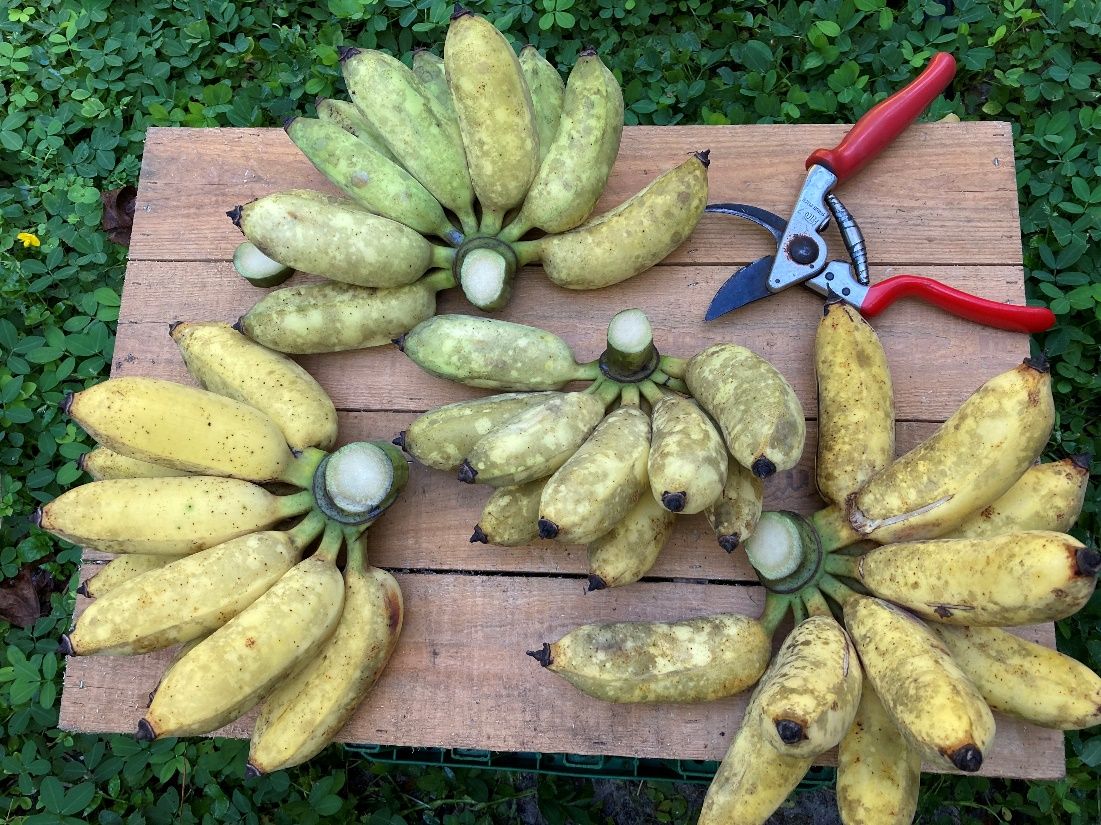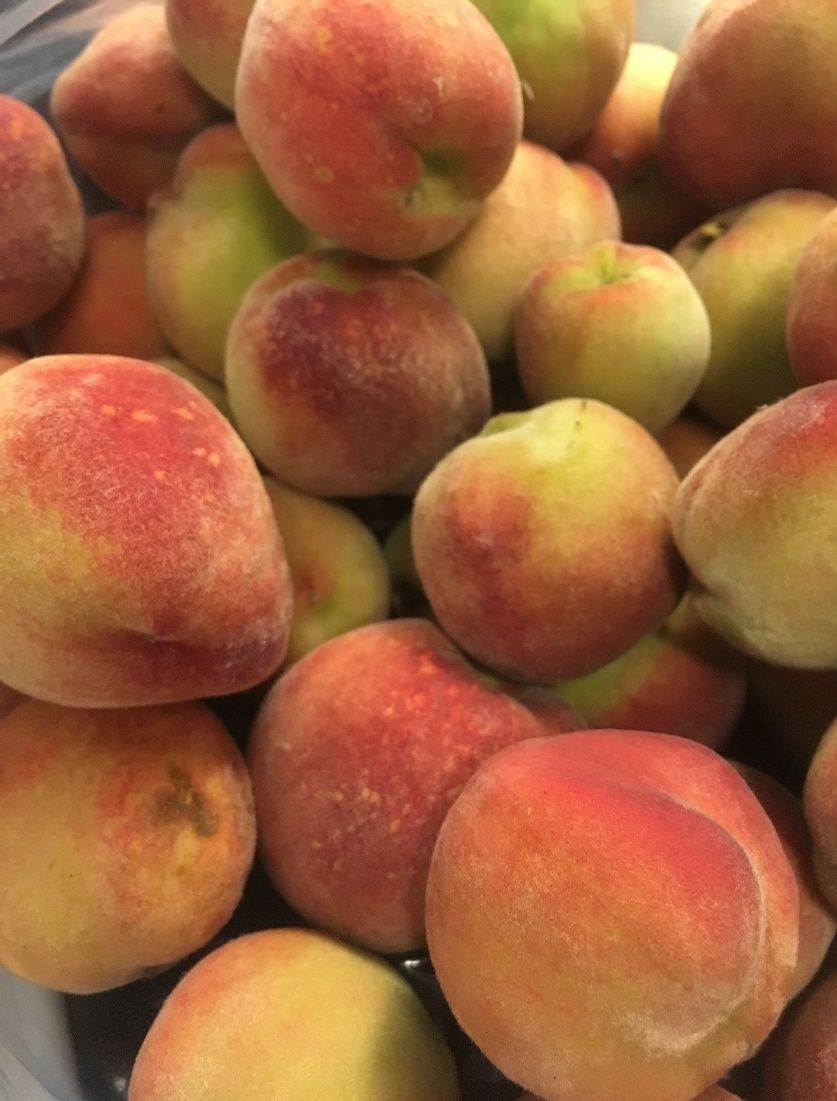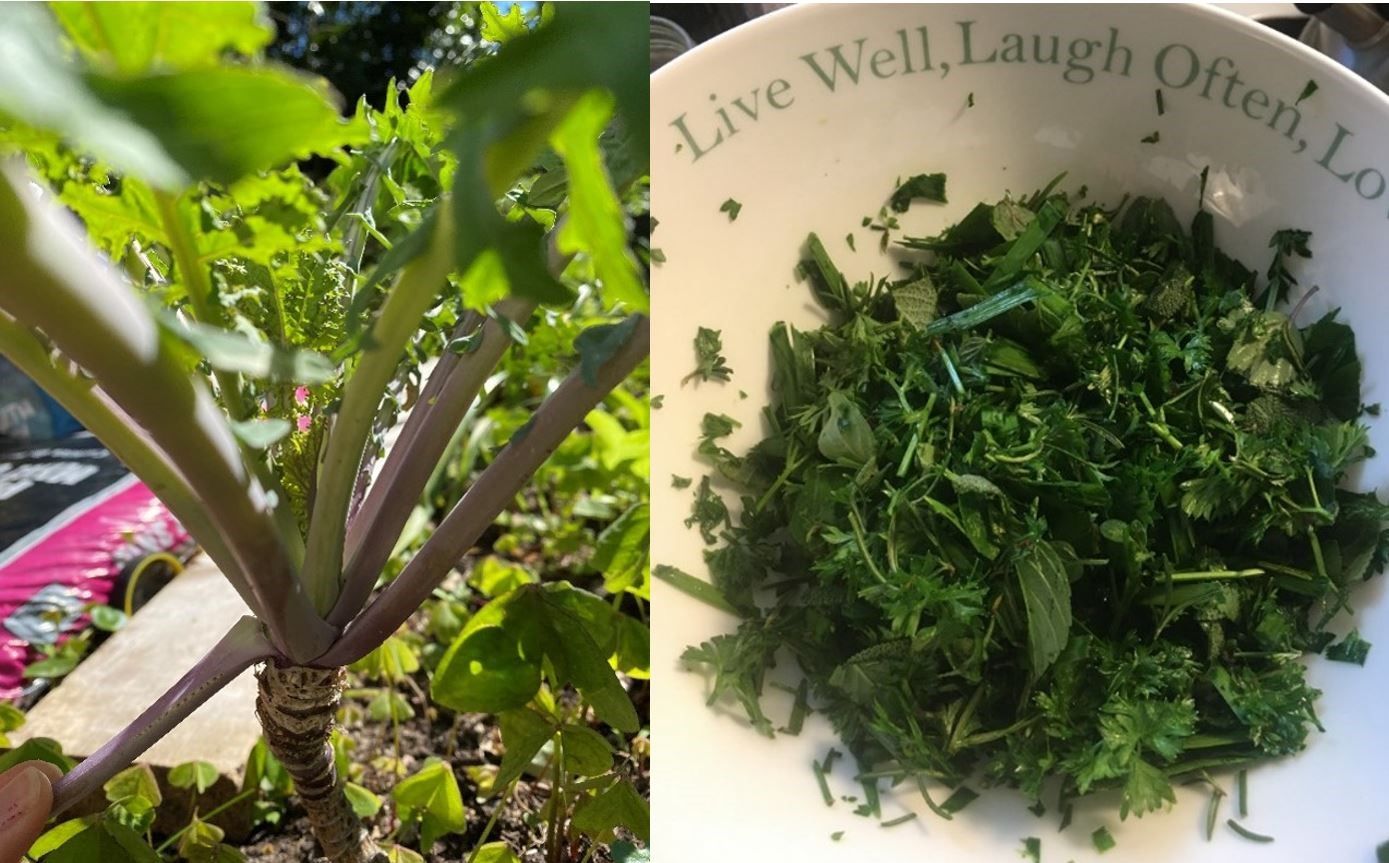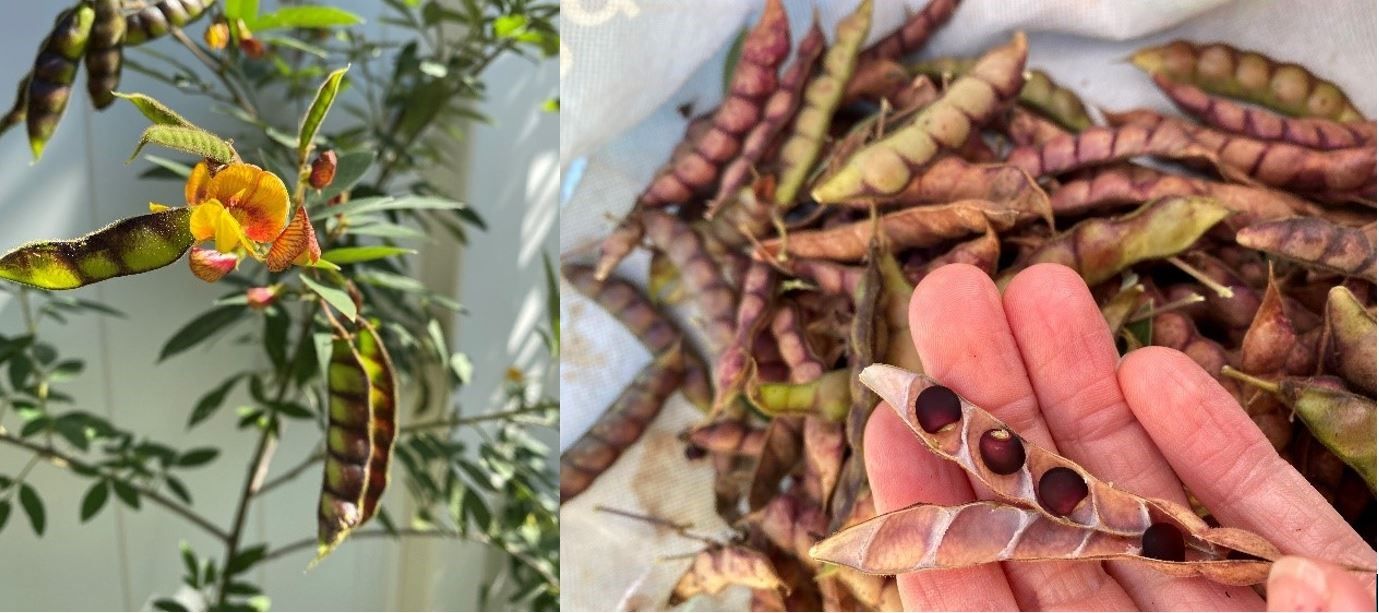Introduction
The Florida-Friendly Landscaping™ Program (FFL) preserves and protects Florida’s water resources. The nine FFL principles are promoted by public outreach and education statewide. The principles are:
- Right plant, right place
- Water efficiently
- Fertilize appropriately
- Mulch
- Attract wildlife
- Manage yard pests responsibly
- Recycle yard waste
- Reduce stormwater runoff
- Protect the waterfront
Maintaining an edible landscape using the nine Florida-Friendly Landscaping™ (FFL) principles provides a practical approach to food production in the home environment. Integrating pest management strategies, addressing nutrient deficiencies, proper pruning techniques, timely harvesting, and mulching are all practices that contribute to having a healthy edible landscape. The audience for this publication is Floridian homeowners attempting to grow edibles, such as vegetables, fruits and herbs.
How can this article help you?
This publication covers the basics for maintaining edible landscapes that are already established. In this article, we define “maintenance” as pruning, harvesting, watering, mulching, fertilizing, weeding, and insect management. Understanding the amount of work you want to put into your landscape will help you select plants and design your garden. For details on other facets of FFL for edible plants, refer to https://edis.ifas.ufl.edu/publication/EP594. For composting, visit https://edis.ifas.ufl.edu/publication/EP599. This publication does not cover fertilization in depth. For additional information on fertilization for fruits, visit https://trec.ifas.ufl.edu/fruitscapes/ and search by individual fruit type.
General Assessments and Seasonal Practices
Once your edible landscape is established, assess it every season to establish how much maintenance is required for your edible plants to be productive and aesthetically pleasing. Focus on the health of trees by scouting frequently, mulching around plants and paths when necessary, and pulling weeds while they are young and easy to remove. Standard garden practices like trellising vines, raking leaves into beds, and pulling weeds not only maintain your garden, but improve quality of life by enhancing air quality, improving mental health and learning, and reducing stress (International Society for Horticultural Science 2012).
The two major seasons in Florida are the wet season (May to October) and the dry season (November to April). Seasonal changes affect general maintenance practices like irrigation, weeding, pest management, and replenishing mulch. For example, during the rainy season, reduce irrigation and monitor plants so weeds do not overtake your vegetable or herb garden. Additionally, the rain may have washed away mulch and compost, so reapply these as needed. During the dry season, irrigation is important to maintain the health of your edible landscape. The dry season is often the pruning season as well because plants can heal with a lower risk of fungal infection. Scouting for insect pests should be practiced throughout the year. For more information on pest management in edible landscapes, see Natural Products for Managing Landscape and Garden Pests in Florida: https://edis.ifas.ufl.edu/publication/IN197.
Close monitoring will help you determine how frequently to compost, prune, and irrigate. In general, you want to fertilize plants around the time that they start to actively grow. You can lightly prune ornamental trees and shrubs as needed to maintain shape and heavily prune when they are dormant. For fruit trees, different species have different pruning rules, but pruning should occur after harvest of fruits. For irrigation, you generally want to maintain moist, well-draining soils that encourage deep root growth and minimize fluctuations in water availability. Finally, utilize the nine FFL principles to appropriately care for your garden, starting with selecting the right plant for the right place, which will minimize unnecessary garden maintenance.
Planting and Establishing Your Edible Plants
Before planting, be sure to test the soil pH and nutrient content and amend the soil accordingly. In areas that were previously weedy or contained invasive or dead plant material, remove all weeds and invasive plants. After removing or eliminating vegetative material, solarization is recommended. This will kill any remaining weed seeds and can reduce pest populations; see Introduction to Soil Solarization: https://edis.ifas.ufl.edu/publication/IN856. Mixing finished compost or manure into soil or broadcasting compost onto the soil a few weeks before planting will ensure nutrients for the transplants. For information on soil testing, contact the UF/IFAS Extension Soil Testing Laboratory: http://soilslab.ifas.ufl.edu/.
Transplants and seedlings require frequent watering until they are established. A plant is considered established when it can survive on rainfall alone. Annuals and edibles producing fruit will require more frequent irrigation. Refer to the Florida Vegetable Gardening Guide: https://edis.ifas.ufl.edu/publication/VH021. For perennial shrubs, refer to Establishing Shrubs in the Florida Landscape: https://edis.ifas.ufl.edu/publication/EP391. While assessing your landscape, you may notice that some plants have died. Some seeds may not have ever sprouted, and the roots of some transplants may not have successfully taken to the environment. Before replacing those, be sure to prepare the area and remove the dead plant debris. This may be a seasonal practice, or one that occurs in the weeks after planting, so monitor your garden often to ensure success and high yield.
Tools
Clean, sharp tools make precise cuts and allow plants to heal quickly, reducing the chance of infection or insect infestation. Some examples of common garden tools for pruning and harvesting are spades and trowels, shovels and rakes, hand pruners/pruning shears, and hoes. The stirrup hoe, also known as the scuffle or hula hoe, is a fantastic tool for eradicating small weeds or working the sandy Florida soil. Larger tools like loppers should be used on trees or thick branches of shrubs (Figure 1). These tools will make for easier care of your edible landscape. For more information on types of tools in edible landscapes, visit https://gardeningsolutions.ifas.ufl.edu/care/tools-and-equipment/garden-tools.html.

Credit: Tina McIntyre, UF/IFAS
Tools should be cleaned after trimming each plant and after you finish using them. Tools should be regularly sharpened to maintain their quality and efficiency. For information on sanitizing tools, see https://sfyl.ifas.ufl.edu/media/sfylifasufledu/baker/docs/pdf/horticulture/DisinfectingPruningTools.pdf. Read more about sharpening tools at https://gardeningsolutions.ifas.ufl.edu/care/tools-and-equipment/sharpening-your-tools/.
Below are some useful tools for basic garden maintenance:
- Hand pruners (Figure 2)
- Loppers
- Stirrup hoe

Credit: Tia Silvasy, UF/IFAS
Irrigation
Improper or broken irrigation can result in inefficient watering and lower yields. To determine if your irrigation system is working correctly, turn it on and inspect its operation. Monitor for geysers, excessive pooling, or dry areas. These issues can often be easily resolved at home. Flush out irrigation systems to clear out debris that may have accumulated, which is a common issue in microirrigation systems. It should be noted that different irrigation systems (e.g., rotors, microirrigation, drip irrigation, manual irrigation) will require different solutions. A basic practice to run irrigation efficiently is to adjust irrigation timing by increasing intervals during the rainy season and shortening intervals in the dry season. For more information, see Efficient Irrigation for Florida-Friendly Edibles: https://edis.ifas.ufl.edu/publication/ep617.
Pruning
Prune to ensure your fruit trees and shrubs are structurally stable and resilient to storms and to remove dead or damaged growth. Pruning also encourages larger fruit development, rejuvenates the plant, increases flowering or fruiting, and maintains a specific size of the tree for easy access to the fruit. Basic aspects of proper pruning include the following:
- Clean pruning tools before use on other plants.
- To thin a tree, remove branches back to a lateral branch, trunk, or ground.
- Remove yellow, dead or diseased branches.
- Most of these garden trimmings can be recycled or composted. However, do not compost diseased plant parts, because pathogens can persist in compost. Any infected debris should not be placed in your yard recycling. It should be disposed of in your household trash to decrease the possibility of spreading pathogens.
Pruning strategies are based on crop needs. Because pruning is specialized to specific plants, it is important to research the plant that you are pruning. For example, removing and pruning tomato shoots promotes more flower growth, resulting in greater fruit production. Removing the flowers of peach and citrus trees during the first two years allows young trees to focus more energy into the roots and leaves of the plant. They will be healthier and more robust, yielding greater fruit production in later years (Figure 3). The same principles apply on a smaller scale to herbs. When handling herbs such as basil, pinching back the stem every one to two weeks prevents leggy growth (Figure 4).

Credit: Tina McIntyre, UF/IFAS

Credit: Tina McIntyre, UF/IFAS
Pruning just before spring growth begins leaves fresh wounds open for a short time before new growth can seal the wound. In Florida, prune in the fall and winter, when the plant is dormant. Improper pruning can inhibit yield and create environments that are ripe for plant pathogens or insect infestations. For more information on pruning deciduous fruit trees and good practices in pruning, visit https://gardeningsolutions.ifas.ufl.edu/care/pruning/pruning-deciduous-fruit-trees/.
Trellising and staking are also an important part of garden and edible landscape maintenance. Muscadine grapes, passion fruit, hops, and some peas and beans require staking in early growth stages to train the vines upward onto a trellis or arbor. Doing this prevents fruits from settling on the ground, making the fruit and plants susceptible to insect pests and diseases. Chayote squash is related to cucumbers and other squash in the Cucurbitaceae family, whose members have tendrils along their stems that grab wires and stakes. Staking these plants makes it easier to pick the fruits and keeps the plant and fruit cleaner.
Harvesting
Harvesting is an important part of maintaining an edible landscape. Consuming the edibles produced on site is not only a way to enjoy fresh food, but the ritual of harvesting also helps identify plant needs. Many annual crops will have the number of “days to harvest” listed on the seed packet, but if you are growing perennial edible shrubs and trees, that information may not be available. Watch for buds, then flowers (Figure 5). Once the flower is pollinated, the ovary will start to swell and become the fruit. It is especially important to observe the fruit as it nears maturity because animals or insects might also be interested in the fruit as it ripens.

Credit: Tina McIntyre, UF/IFAS
Most fruits and vegetables will change color as they ripen and begin to emit their signature fruity scent. There are many harvesting methods available depending on the plant. These include hand harvesting, harvesting with hand tools, and harvesting with machinery (Figure 6). Any tools used in harvesting should be cleaned and sanitized before using them on other plants to prevent disease transmission.

Credit: Tina McIntyre, UF/IFAS
Harvesting fruit when it is not ripe may ensure you successfully get the fruit, but it might not be as enjoyable, because ripening converts starches to sugars when the fruits approach peak ripeness. Climacteric fruits continue ripening after being picked, a process accelerated by ethylene gas. Nonclimacteric fruits can ripen only on the plant and have a short shelf life if harvested when they are ripe. Examples of climacteric fruits include bananas, cantaloupe, peaches, and avocados. Examples of nonclimacteric fruits are citrus fruits, watermelon, grapes, starfruit, and strawberries.
Table 1. This table lays out how each type of edible is defined, how to best prune, and harvest. Examples are added for clarity.
We would like to acknowledge Claire Lewis, Lyn Barber and Terra Freeman for their contributions to this publication.
References
Archer, L., M. Brewer, B. Adhikari, E. Esteves, C. Vincent, and T. Vashisth. 2021. “Management Options for Improving Flowering in Citrus Production.” EDIS 2021 (1): 6. https://doi.org/10.32473/edis-hs1399-2020
Borden, M. A., E. A. Buss, S. G. Park Brown, and A. G. Dale. 2018. “Natural Products for Managing Landscape and Garden Pests in Florida.” EDIS 2018 (5). https://doi.org/10.32473/edis-in197-2018
Lamborn, A. R. n.d. Disinfecting Pruning Tools. Macclenny, FL: UF/IFAS Extension Baker County.
Liu, G. D., E. H. Simonne, K. T. Morgan, and G. J. Hochmuth. 2018. “Soil and Fertilizer Management for Vegetable Production in Florida.” EDIS 2015 (1). https://edis.ifas.ufl.edu/cv101
Marble, C., and A. Koeser. 2022. “Improving Weed Control in Landscape Plantings Beds.” EDIS 2015 (3). https://edis.ifas.ufl.edu/ep523
McIntyre, T., R. Gutner, and S. Wilson. 2021. “Concepts for Sustainable Landscape Mosaics.” EDIS 2021 (3). https://doi.org/10.32473/edis-ep605-2021
Park Brown, S., D. Treadwell, J. M. Stephens, and S. Webb. 2021. “Florida Vegetable Gardening Guide.” EDIS 2015 (5). https://edis.ifas.ufl.edu/publication/VH021
Rivas, J., T. Silvasy, L. Harlow, L. Barber, J. Marvin, E. Momol, T. McIntyre, and T. Freeman. 2022. “Efficient Irrigation for Florida-Friendly Edible Landscapes.”EDIS 2022 (1). https://doi.org/10.32473/edis-ep617-2022
UF/IFAS Gardening Solutions. 2016. “Peaches.” https://gardeningsolutions.ifas.ufl.edu/plants/edibles/fruits/peaches/
University of Minnesota Extension. 2022. “Pruning Trees and Shrubs.” https://extension.umn.edu/planting-and-growing-guides/pruning-trees-and-shrubs
Williamson, J. G., F. S. Davies, and P. M. Lyrene. 2004. “Pruning Blueberry Plants in Florida.” EDIS 2004 (12). https://doi.org/10.32473/edis-hs223-2004